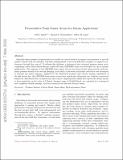| dc.contributor.author | Dusek, Jeff Ernest | |
| dc.contributor.author | Triantafyllou, Michael S | |
| dc.contributor.author | Lang, Jeffrey H | |
| dc.date.accessioned | 2018-10-12T16:26:33Z | |
| dc.date.available | 2018-10-12T16:26:33Z | |
| dc.date.issued | 2016-07 | |
| dc.date.submitted | 2016-05 | |
| dc.identifier.issn | 0924-4247 | |
| dc.identifier.uri | http://hdl.handle.net/1721.1/118459 | |
| dc.description.abstract | Spatially-dense pressure measurements are needed on curved surfaces in marine environments to provide marine vehicles with the detailed, real-time measurements of the near-field flow necessary to improve performance through flow control. To address this challenge, a waterproof and conformal pressure sensor array comprising carbon black-doped-silicone closed-cell foam (CBPDMS foam) was developed for use in marine applications. The response of the CBPDMS foam sensor arrays was characterized underwater using periodic hydrodynamic pressure stimuli from vertical plunging and surface water waves, from which a piecewise polynomial calibration was developed to describe the sensor response. Inspired by the distributed pressure and velocity sensing capabilities of the fish lateral line, the CBPDMS foam sensor arrays have significant advantages over existing commercial sensors for distributed flow reconstruction and control. Experimental results have shown the sensor arrays to have sensitivity underwater on the order of 5 Pa, dynamic range of 50–500 Pa; are contained in a waterproof and completely flexible package, and have material cost less than $10 per sensor. Keywords: Pressure sensors; Carbon black; Smart-skins; Hydrodynamics; Foam | en_US |
| dc.publisher | Elsevier BV | en_US |
| dc.relation.isversionof | http://dx.doi.org/10.1016/J.SNA.2016.07.025 | en_US |
| dc.rights | Creative Commons Attribution-NonCommercial-NoDerivs License | en_US |
| dc.rights.uri | http://creativecommons.org/licenses/by-nc-nd/4.0/ | en_US |
| dc.source | arXiv | en_US |
| dc.title | Piezoresistive foam sensor arrays for marine applications | en_US |
| dc.type | Article | en_US |
| dc.identifier.citation | Dusek, Jeff E. et al. “Piezoresistive Foam Sensor Arrays for Marine Applications.” Sensors and Actuators A: Physical 248 (September 2016): 173–183 © 2016 Elsevier B.V. | en_US |
| dc.contributor.department | Massachusetts Institute of Technology. Department of Electrical Engineering and Computer Science | en_US |
| dc.contributor.department | Massachusetts Institute of Technology. Department of Mechanical Engineering | en_US |
| dc.contributor.mitauthor | Dusek, Jeff Ernest | |
| dc.contributor.mitauthor | Triantafyllou, Michael S | |
| dc.contributor.mitauthor | Lang, Jeffrey H | |
| dc.relation.journal | Sensors and Actuators A: Physical | en_US |
| dc.eprint.version | Original manuscript | en_US |
| dc.type.uri | http://purl.org/eprint/type/JournalArticle | en_US |
| eprint.status | http://purl.org/eprint/status/NonPeerReviewed | en_US |
| dc.date.updated | 2018-09-25T18:28:04Z | |
| dspace.orderedauthors | Dusek, Jeff E.; Triantafyllou, Michael S.; Lang, Jeffrey H. | en_US |
| dspace.embargo.terms | N | en_US |
| dc.identifier.orcid | https://orcid.org/0000-0002-7010-9250 | |
| dc.identifier.orcid | https://orcid.org/0000-0002-4960-7060 | |
| dc.identifier.orcid | https://orcid.org/0000-0002-5765-4369 | |
| mit.license | PUBLISHER_CC | en_US |
